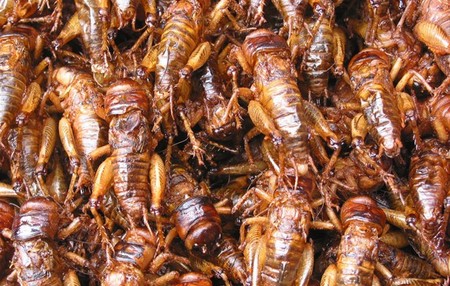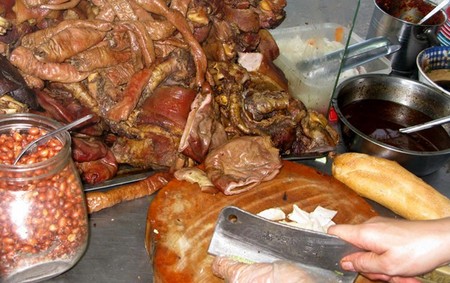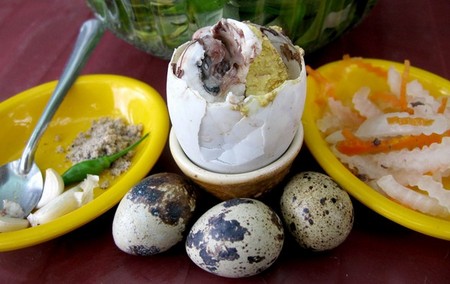Vietnam’s most challenging foods

Bugs
Fried crickets, raised on farms, are light and crispy like popcorn.
Vietnam's ethnic Khmer in the Mekong Delta are among the country's most adventurous eaters of insects and arachnids, though some hill tribers lso enjoy snacking on giant water bugs, tarantulas and scorpions. The mst commonly eaten include crickets, bee larvae and silk worms. Most bugs are fried and take on the flavor of their seasonings. They have very little flavor of their own.
Frogs

The tastiest frogs are grilled with lemon grass and chili.
Vietnamese don't just eat frog's legs. After gutting and skinning these tubby, cartoonish bullfrogs, they then try, steam or grill the whole animal. One exception: on the evening of the first heavy rain, villagers gather a particular species of smooth-skinned toad, which is boiled whole, the stomach muscle removed, and then the entire animal eaten-skin, guts and all, with some lemon, salt and pepper.
Pha Lau

Pha Lau is popularly added to noodle soups and hot pot. Of all the unusual foods listed here, it is the most common one for tourists to encounter at mealtime.
Vietnamese don't waste any part of the animal. Pha lau stands display piles of beef and pork intestines, lungs, kidney, heart and stomach. The tasty innards are chopped up and loaded into baguette sandwiches or sold by the plate to company rounds of beer or rice wine.
Squid teeth
Squid teeth are popular in coastal towns -- always served in the vicinity of a fisherman's wharf or fresh seafood market.
Squid teeth (rang muc) are another example of Vietnamese resourcefulness. The mouth parts of squid form a white, marble-sized ball with a tiny black beak protruding at the end. Steamed with ginger, grilled on a kebab or friend in batter, they are a popular after-school snack or market food for moms on-the-go.
Fetal duck eggs

In Vietnam, both fertilized duck eggs (known as trung vit lon) and tiny fertilized quail eggs are a popular snack.
Fertilized duck eggs are a very popular snack, appetizer or beer food. The contents are much harder than a conventional boiled egg, with a partially formed duck fetus inside. There may be visible signs of feathers but they dissolve in the mouth. The top is cracked, juices slurped, and then the contents are eaten with a spoon. Popular condiments include lemon and black pepper, fresh herbs, pickled veggies, raw garlic and green chili.
A note on eating wildlife
Unfortunately some restaurants in Vietnam serve wild game -- some of it threatened or endangered, and much of it illegal. Guidebooks and television programs sometimes recommend these venues, ignorant of the issues involved. The Travel Channel recently faced this issue when the Wildlife Conservation Society successfully persuaded them to re-edit episodes of "No Reservations" and "Bizarre Foods" that contained questionable wildlife consumption in Vietnam and Cambodia respectively.
Vietnam's allows wildlife 'farms' to operate if they buy a permit. But many of these farms still tend to source their stock from poachers, often involving tiger parts, bear bile and Rhino horns smuggled from Africa.
As such, all restaurants serving exotic animals here should be strictly avoided, and should not be considered bizarre, but illegal.










 Share:
Share:




